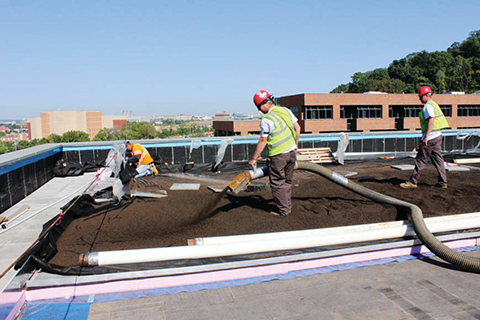
Extensive roof cover media varies in depth between 50 and 150 mm (2 and 6 in.), with a weight increase of between 78 to 171 kg/m2 (16 to 35 lb/sf) when saturated. Intensive vegetative roof cover media varies in depth between 200 and 600 mm (8 and 24 in.), with a weight increase to 293 to 976 kg/m2 (60 to 200 lb/sf) when saturated.
Vegetative roofs provide a thermal mass effect, which in turn saves energy and provides reduced heating and cooling costs. Other benefits include reduced water runoff, extended useful life of the roof (due to reduced exposure of the membrane to harmful ultraviolet [UV] light and weather), and added beauty and usable space.
Among the many sustainability objectives of a vegetative roof, the most critical are retaining water and reducing stormwater discharge, and conserving energy through the cooling and shading of soil and plantings. This reduces heat flow into a building, lowering the load placed on air-conditioning equipment.
Long-term exposure to moisture makes it imperative the insulation of vegetative roof systems retains R-value, possesses adequate compressive strength, and provides other critical properties while exposed to water. For that reason, XPS is almost exclusively used to insulate vegetative roofs.
When specifying, selection may be from ASTM C578 Type VI (276 kPa [40 psi]), Type VII (414 kPa [60 psi]), or Type V (690 kPa [100 psi]) XPS to best fit the roof’s design requirements. The material is also durable, making it reusable when removal and reinstallation are needed for maintenance or for repairs to the membrane. For all these characteristics, XPS is typically the only insulation recommended for vegetative roofs where the assembly requires insulation above the waterproofing membrane.
Below-grade applications
The most efficient way to insulate a building foundation is with continuous insulation around the exterior. Moisture resistance is important because precipitation eventually finds its way to the foundation. Since soil holds different amount of moisture, the insulation’s moisture resistance is important for energy savings and interior comfort for occupants. Providing drainage does not always negate the need for moisture-resistant insulation.
Insulations used in the foundation application must also withstand significant abuse during the backfilling. The protection the foam insulation provides to the foundation waterproofing membrane during this operation is also important. Foundation insulation must have superior durability and be able to withstand the soil’s lateral compressive forces that depend on:
- depth to which the insulation is used;
- soil type; and
- potential for live loads (e.g. pedestrians or vehicles).
It is also important to select the appropriate ASTM C578 type based on the required compressive strength satisfying the application’s needs. Industry experience has shown XPS to provide superior performance in the exterior foundation insulation application.

Frost-protected shallow foundations
In FPSF designs, foam insulation is positioned around the foundation to prevent frost from developing below the foundation wall and footer. Figure 3 illustrates a typical frost-protected shallow foundation compared to a conventional foundation.
During cold weather, frost in the soil leads to the formation of ice lenses that grow, expand, and heave the ground upward. Mild weather thaws the soil and the ice lenses melt and the soil above them sinks. This freeze-thaw cycling causes frost-heave damage to footings, foundations, slabs, and pavement.
For buildings constructed on frost-protected shallow foundations, structural performance greatly depends on the long-term thermal performance of the foundation insulation. FPSFs must be designed with insulation considering the appropriate long-term effective R-values that account for the detrimental effects of moisture absorption, because performance deficiencies can result in more than just higher energy costs and comfort issues.
To maintain the building’s structural integrity (and to reduce heating energy consumption), the FPSF insulation must prevent the soil under the foundation from freezing for the life of the building. Therefore, it is important to know the insulation’s thermal performance and moisture-resistance properties, along with the long-term effective R-value in these demanding below-grade environments.





I visited many websites except the audio feature for audio songs current at this site is in fact excellent.